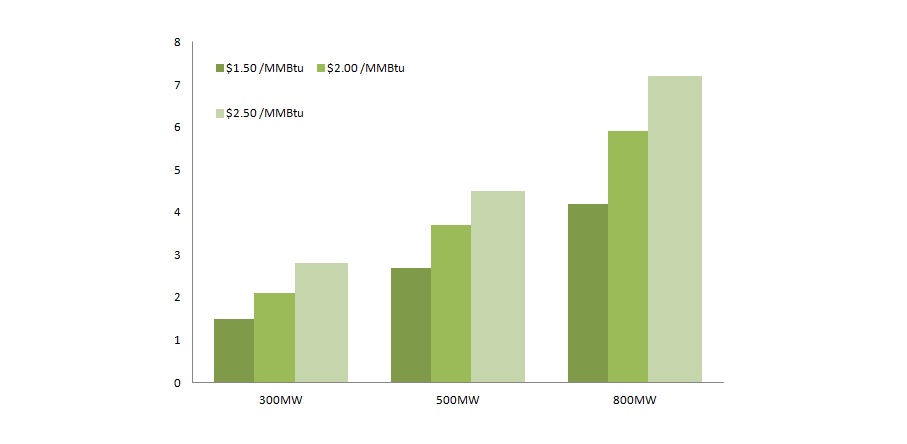The global coal-fired power capacity has grown significantly since 2000 to about 2,045 Gigawatts (GW) currently. Despite this progress, the last couple of years has seen several plants retire in the US and Europe. One fact remains though: coal fired power plant technology is not going anywhere. Perhaps it is with this fact in mind that many operators are interested in strategies for heat rate of power plant improvement. The 1,857-MW coal-fired power plant case study at the Jeffrey Energy Center is a perfect example of the significant savings that a typical power plant can accrue with a lower heat rate. However, are coal-powered plants aware of the opportunities that exist? Let’s see how to improve heat rate of thermal power plant by pointing out some of the areas that could be exploited.
What is Heat Rate of Power plant?
Before that, we need to relook at this term. The viability of a power plant connected to thermal efficiency. Heat rate is a metric that is inversely proportional to power plant efficiency, thus equally crucial. It is a comparison of the amount of heat capable of generating 1 kilowatt-hour (kWh) of power.
(3,412 Btu/kWh÷heat rate) × 100 = % thermal efficiency of a power plant
Because of the inverse proportionality to efficiency, it follows that higher heat rate of power plant is undesirable. Three factors determine the heat rate of a plant: Electric Power Output, Operating Conditions and Plant Design. However, most of the existing power plants have heat rates of between 9,000 Btu/kWh and 11,000 Btu/kWh.
Historical Perspective of Heat Rate
With power plants in the United States as a reference point, heat rates for fossil-fueled power plants have been increasing steadily since the mid-1960s. Some of the factors that have contributed to this are emergence of nuclear power plants and subsequent shift of attention, lack of maintenance funds, environmental regulations and frequent cycling. These factors, either individually or in combination, have prompted a steady increase in heat rates. This problem is not confined to the United States; other regions have experienced similar scenarios.
Can power plants reverse such factors and achieve power plant power augmentation? How necessary is such a step?
Why Heat Rate Reduction Is Important
Consider the previously mentioned fact that heat rate of power plant is usually between 9,000 Btu/kWh and 11,000 Btu/kWh and that coal costs about $30/Ton. With a standard coal powered power plant consuming 6,000 tons per day, it is evident why fuel makes the largest expense for this type of power plant. Some experts put it at about 75% of total expense! The good thing is that even the slightest reduction (as little as 1%) in heat rate can translate into significant annual savings. For the case of the Electric Power Research Institute (EPRI) project, the following figure shows the fuel cost savings following a 5% heat rate improvement.

Fig 1: Fuel Cost Savings for 5% Heat Rate Reduction
To add to the money savings, heat rate improvement reduces carbon dioxide and other emissions. Indeed, experts consider it the most cost-effective method of lowering these emissions. In case of regulations that support carbon dioxide trading, the emissions reduction can also bring significant savings. The other emissions that are manageable thanks to heat rate of power plant improvement are mercury, particulates, nitrogen oxides (NOx) and sulfur dioxide (SO2).
Heat Rate Improvement Strategies
The EPRI created a methodology of assessing the benefits of capital and maintenance improvements to coal power plants, and the results were eye opening. The six steps that these methodologies focused on were:
- Major systems in a plant
- Potential projects for individual systems - identify
- Input data and values
- Potential projects for individual systems – characterize
- Potential findings and uncertainty
- Check input data and results
After identifying underlying issues including need for training, information inadequacy, combustion problems and poor performance of feed water heater train, recommendations for improving heat rate power plant in a cost effective manner are as below:
- Cycle Alignment- Also called cycle isolation, this intervention reduces fluid leakage through valves
- Remote Monitoring Centers – RMSs help monitor and improve heat rate
- Adjustments and Modifications for Cyclic Operations – Load following, cyclic and part load modes are flexible operations of a plant. Regular swings of pressure and temperature harm the plant. Some changes can minimize this negative effect.
- Creation and adherence to a Heat Rate Improvement Program- Application of this program enhances plant performance
- Focus On Steam Turbine Performance – power output and efficiency
Steam Turbine Efficiency
Gas Turbine Power Augmentation using Turbine Inlet Air Cooling (TIAC) is a popular and reliable upgrade strategy for heat rate improvement in gas-powered power plants. It is a group of technologies and techniques whose objective is cooling down the intake air of the gas turbine and ultimately power output augmentation. This technology is widely used in hot climates with high ambient temperatures that usually coincide with on-peak power demand. If operating flexibly, the plant can still realize lower heat rate by using variable speed drives, monitoring performance, optimizing the cooling system, and minimizing oscillations for temperature, flow and pressure. Other solutions are optimal partial load operation, sliding pressure operation and reduction of warm up flow for boiler feed pump.
Conclusion
Power plants typically have potential for improvement, as various EPRI studies have shown. If a plant identifies the opportunities and pursues heat rate of power plant improvement as suggested, heat rate may improve by several percentage points. As experience has shown, it may not be possible to exploit all the recommended improvements, but any method can bring significant cost savings and reduction of emissions. Consider power augmentation for that extra thermal efficiency and improved bottom line. For more details on optimization possibilities for coal powered plants, please contact experts at ARANER.










